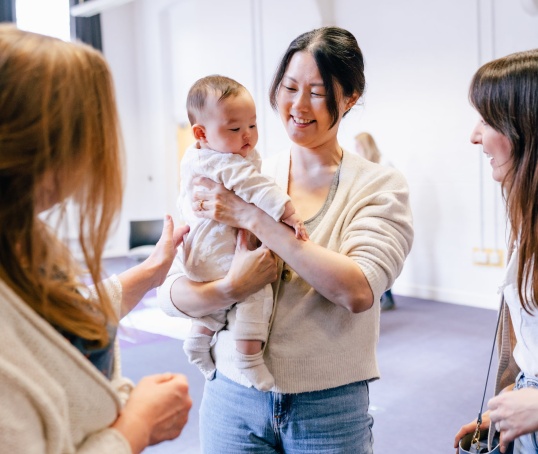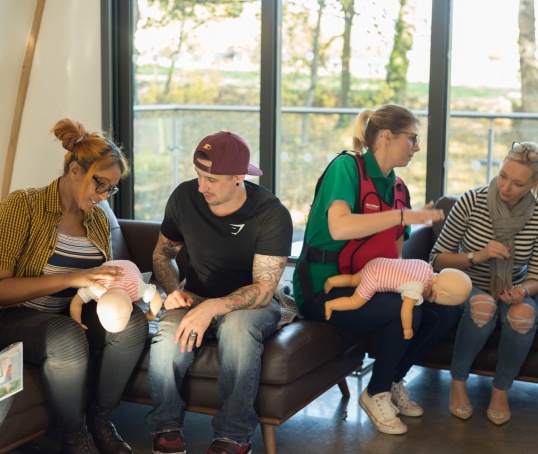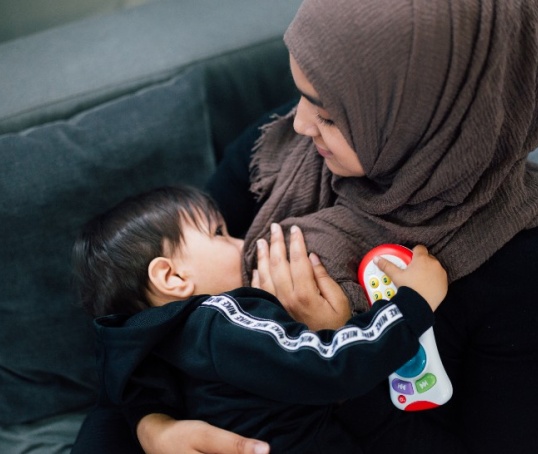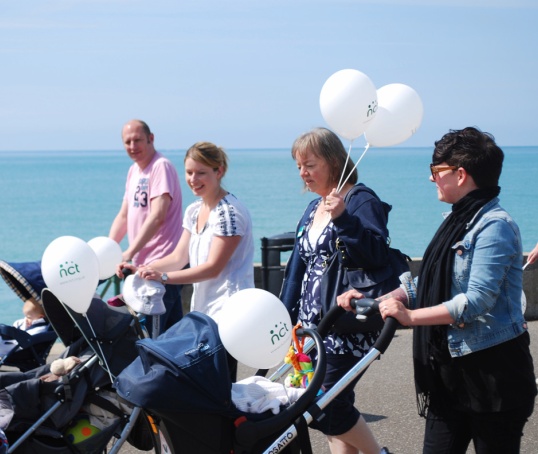What happens after the birth of the baby or babies and placenta (or placentas)? Find out more about the minutes and hours after both vaginal and caesarean birth.
The first 1-2 hours after birth
The mother or birthing parent should have as much uninterrupted time as possible with their baby for at least one hour (and ideally two) immediately after birth (NICE, 2023). They are getting to know each other in this important period, which is sometimes referred to as the ‘golden hours’.
Routine procedures like weighing and measuring the baby are done later, unless requested by the parent or essential for the baby’s care (NICE, 2023).
Skin-to-skin contact
As soon as the baby is born, it is recommended that the baby be placed on the mother or birthing parent’s bare chest. A blanket or warm dry towel can be placed over the baby for warmth. This is called skin-to-skin contact (NICE, 2023; Unicef, no date).
Skin-to-skin contact has been shown to help with breastfeeding both immediately and longer term (Moore et al, 2016).
However, it’s not just about feeding. Skin-to-skin contact is considered important for all babies because it (Unicef, no date):
- calms the mother or birthing parent and baby
- regulates the baby’s heart, breathing, and temperature
- stimulates strong instinctive behaviours in both baby and parent, and the hormones which support both feeding and parenting
- helps friendly bacteria move from mother or birthing parent to the baby
If the mother or birthing person isn’t well enough, the birth partner is encouraged to have skin-to-skin contact instead (NICE, 2023).
NHS Start for Life has more information about skin-to-skin.
Checks on the baby
The APGAR score, where the midwife checks skin colour, heart rate, reflex response, muscle tone and breathing, will be recorded at 1 minute and 5 minutes after birth (NICE, 2023). Because it’s a very quick check you probably won’t notice it is happening. Read more about the baby’s postnatal checks.
If the baby’s breathing or heart rate seem abnormal, the medical team will assess and continue to monitor them. One member of the team should keep you informed of what is happening throughout the baby’s care (NICE, 2023).
Immediate care of the baby
The baby will be (NHS, 2022 a):
- dried and covered with a towel to keep them warm. They won’t be bathed because that could cool them down. Some babies have a lot of vernix, a greasy white substance which protects their skin. They may also have some blood and poo on their skin.
- given name bands if in hospital
- offered vitamin K
- given additional care if needed
First feed
If the mother or birthing parent is planning to breastfeed, they will be encouraged to start breastfeeding as soon as possible. Ideally this will be within an hour of birth (NICE, 2023).
If the plan is to formula feed, a first feed is encouraged within this period.
Early feeding supports the newborn’s instinctive feeding behaviours and helps stabilise blood sugar levels.
Immediate feelings
People have all kinds of feelings immediately after giving birth. There is no need for the mother or birthing parent to worry if they don’t feel a certain way.
It is common to feel cold or shaky in the first couple of hours after birth. The mother or birthing parent might appreciate reassurance, a hug, and a blanket and hot drink.
Following hours
Over the next few hours, the baby or babies, and mother or birthing person will be checked and monitored to make sure they are recovering well (NHS, 2022 a).
Care of the baby
After the golden hours the baby will be weighed and measured (NHS, 2022 a).
Within 72 hours of birth the baby has a newborn and infant physical examination (NIPE). This takes place either in hospital or at home (NHS, 2024).
Read more in our article on the baby’s postnatal checks.
Care of the mother or birthing parent
The maternity staff will check the mother or birthing person by (NHS, 2022 b; NICE 2023):
- taking their temperature, pulse, blood pressure and breathing
- feeling their tummy to make sure the womb is starting to shrink
- checking the vaginal bleeding, which is also known as lochia (lock-ee-ur)
After a vaginal birth
- checking for grazes and tears and making any stitches needed
- examining the placenta, and consulting with a doctor if the placenta isn’t complete
- making sure they have had a wee within 6 hours, and if not consulting with a doctor
After a birth with epidural, spinal, or general anaesthetic
- checking they can lift their leg after 4 hours
- removing any urinary catheter after 12 hours
- assessing their emotional recovery and mental health
- giving them any additional care needed
The midwife or support worker will also help the new mother or birthing parent to freshen up before moving to a postnatal ward or going home (NHS, 2022 a).
Discharge from medical care
The mother or birthing parent, and baby or babies can be discharged within hours after a vaginal birth if they are well. After a caesarean birth or if further medical care is needed, they will move to a postnatal ward or room for a longer stay.
Before the mother or birthing person leaves hospital (or the midwives leave the home in the case of a home birth), midwives will (NICE, 2021 a):
- assess the mother or birthing parent, and baby’s health
- check the mother or birthing parent has had a wee
- make sure the baby has had their first effective feed, and that there is a plan for feeding. This is a good time to raise any concerns about how feeding is going.
They will also talk to the mother or birthing parent about (NICE, 2021 a; NICE, 2021 b):
- if they need any support at home
- seeking medical help if the baby hasn’t passed meconium (the first poo) within 24 hours of birth
- what to expect over the coming days and what to look out for
- pain relief
- wound care if needed
- doing pelvic floor exercises
- who to contact if they have any concerns over the following days
In addition, following a caesarean birth or if the woman or birthing person has other risk factors, information will be provided on (NICE, 2018):
- prevention of deep vein thrombosis (DVT), which could include stockings and medication
Surrogates and intended parents
When a baby is born following surrogacy, the birthing person will have all the same medical care and follow up as anyone else who has given birth.
The intended parents will be provided with the information needed to care for their new baby. They will also receive the medical follow up for the baby.
Following days
The midwife will visit the mother or birthing parent, and baby, within 36 hours of the birth. When the birth has been in hospital it will be within 36 hours of transfer home (NICE, 2021 a). They will explain the plan for care, which might happen at home or a children’s centre (NHS, 2022 b).
The newborn and infant physical examination (NIPE) will be done within 72 hours if it hasn’t already happened (NHS, 2024).
The mother or birth parent will be asked about (NHS, 2022 b):
- any afterpains as the womb shrinks back to its normal size
- blood loss
- how feeding is going, including the milk coming in, which will happen even if not breastfeeding (this happens around day 3 after a vaginal birth but may take longer after caesarean birth)
- how the mother or birthing parent is feeling emotionally
The NHS has information about getting to know your new baby.
Around day 5
The midwife will offer a heel prick check for the baby.
Around day 10
Midwife care will continue to support the mother or birthing person and baby until around day 10, when they will be discharged to a health visitor (NHS, 2022 b).
Within four weeks
The health visitor should visit within two weeks after discharge from the midwife (NICE, 2021 a).
At any time
If there are any worries or questions about feeding the baby in the first few days and beyond, you can contact our Breastfeeding Counsellors on 0300 330 0700. This support includes parents using formula. The line is open every day of the year, from 8am to midnight.
You can also look at our page on all the types of feeding support we offer.
Further information
You can also read our articles on recovery from birth.
Moore ER, Bergman N, Anderson GC, Medley N. (2016) Early skin‐to‐skin contact for mothers and their healthy newborn infants. Cochrane Database of Systematic Reviews, Issue 11. Art. No.:CD003519. https://doi.org/10.1002/14651858.CD003519.pub4
NHS (2022 a) What happens straight after the birth? https://www.nhs.uk/pregnancy/labour-and-birth/after-the-birth/what-happ… [15 Aug 25]
NHS (2022 b) Early days. https://www.nhs.uk/pregnancy/labour-and-birth/after-the-birth/early-day… [31 Jul 25]
NHS (2024) Your newborn baby. https://www.nhs.uk/pregnancy/labour-and-birth/after-the-birth/getting-t… [31 Jul 25]
NICE (2018) Venous thromboembolism in over 16s: reducing the risk of hospital-acquired deep vein thrombosis or pulmonary embolism [NG89]. https://www.nice.org.uk/guidance/ng89 [15 Aug 25]
NICE (2021 a) Postnatal Care [NG194] https://www.nice.org.uk/guidance/ng194 [31 Jul 25]
NICE (2021 b) Caesarean birth [NG192]. https://www.nice.org.uk/guidance/ng192/ [15 Aug 25]
NICE (2023) Intrapartum Care [NG235]. https://www.nice.org.uk/guidance/ng235 [31 Jul 25]





